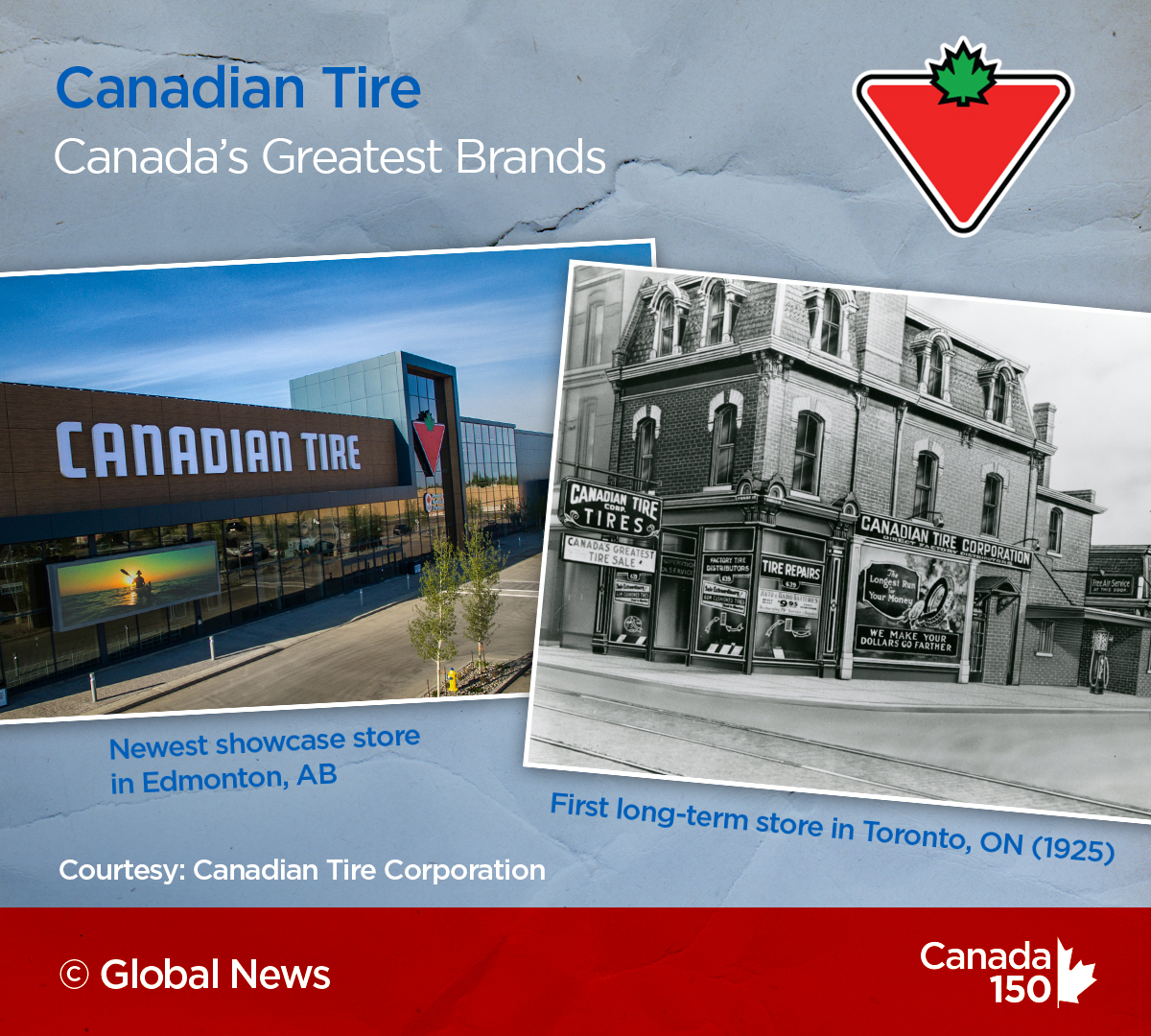National brands are often an integral part of a country’s identity. Whether it’s a popular breakfast cereal or a memorable commercial that regularly airs before bedtime, iconic products are embedded in our childhood and shared memories.

But made-in-Canada helped to make Canada in a literal sense, as well. It was, after all, the drive of enterprises like the Hudson’s Bay Company that laid some of the foundations for what was to later become the Canadian nation.
To celebrate Canada’s 150th anniversary, Global News turned to marketing and brand experts across the country to help select Canada’s greatest consumer brands of all time. Here are our picks:
- What is a halal mortgage? How interest-free home financing works in Canada
- Ontario doctors offer solutions to help address shortage of family physicians
- Capital gains changes are ‘really fair,’ Freeland says, as doctors cry foul
- Canada will take bigger economic hit than U.S. if Trump wins election: report
There are few commercial interests in the world that can claim the nation-building credentials of Canada’s Hudson’s Bay Company (HBC). Founded in 1670, almost 200 years before the country itself came to be, HBC claims to be the oldest company in North America.
Created in order to fetch beaver fur for European felt hats, HBC also came to be involved in the business of providing law and order for settlers in frontier areas the government hadn’t yet reached. The company’s history, like Canada’s, is one of entrepreneurship and resilience but also one intertwined with colonialism. The fur trade helped spread diseases like smallpox, which devastated Aboriginal populations, although HBC noted its traders “did their best” to control epidemics.
Today, HBC is one of the world’s fastest growing department store groups. And from the points blanket to its iconic Olympic mitts, it has drawn on its history and Canadian heritage to build a retail brand, said Maureen Atkinson of J.C. Williams Group, a global retail adviser.
“It just has a different place than any regular retailer will ever have in Canada.”
Canadians haven’t always been as keen on doughnuts and coffee as they are today. Until the mid 1970s, “doughnut shops were considered a fringe part of the restaurant franchise landscape, which was dominated by hamburgers, chicken and ice cream,” according to the Canadian Encyclopedia. It was largely Tim Hortons that changed that, getting an entire nation hooked on double double coffees and glazed doughnuts.
The chain, co-founded by Toronto Maple Leafs defenceman Tim Horton, is arguably as much a part of Canada’s popular culture as hockey. And its quintessentially Canadian spirit has helped it fend off competition from formidable foreign competition like Starbucks.
And though it’s now owned by a Brazilian private equity firm, Tim Hortons is sticking to its Canadian DNA, even in its effort to expand abroad, said Yann Cornil, marketing professor at the University of British Columbia.
“Tim Hortons relies on its Canadian identity even in its international marketing efforts and product placement in popular U.S. TV shows.”
For most Canadians, the name Bombardier conjures up airplanes and trains. But it’s Bombardier Recreational Products (BRP), maker of the popular Ski-Doo snowmobiles, that has remained closer to the company’s humble beginnings and the story so many Canadians learn as children.
The story is that of old Joseph-Armand Bombardier, who in 1920, at age 15, began designing what would become a dramatic improvement on a clunky American prototype of a snowmobile. A lightweight vehicle that could travel through the snow was essential for rural communities such as Bombardier’s own small town of Valcourt, Que., which often remained isolated in winter.
But it wasn’t until after Bombardier’s son Yvon died without hospital care during one such winter, that Bombardier cracked the secret to the modern snowmobile: Caterpillar tracks like those used on tanks. The invention of the sprocket — the toothed wheel that rotates the track — was the first step toward the creation of what was to become one of the world’s transport manufacturing giants.
And the sprocket still features on the logo of BRP, which became its own company in 2003. The Ski-Doo, which Bombardier invented in 1959, remains one of the world’s best-known snowmobiles.
What Canadian winter holiday memory doesn’t include buying Christmas lights at Canadian Tire? And what Canadian home doesn’t hold a pile of Canadian Tire money stashed away in a drawer?
As the name indicates, the company, incorporated in 1927, started out selling tires (at the time Canada had the third-highest car ownership rate in the world, according to the Canadian Encyclopedia).
But after the Second World War, Canadian Tire added camping gear and outdoor leisure items, as visits to national parks boomed and Canadian summers gradually turned into “barbecue season.”
With stores in every province and territory except Nunavut, Canadian Tire enjoys a degree of brand recognition from coast to coast that few other retailers in Canada can claim.
You can thank Lululemon, and Canada, if sweatpants today are now not only cool but sexy.
“As a business success story, it’s hard to beat Lululemon,” Marilyn McNeil-Morin, of the School of Fashion Studies at George Brown College in Toronto, told Global News.
Founded by Chip Wilson in 1998, Lululemon started as a single store in Vancouver that doubled-up as a yoga studio at night. Less than 20 years later, it counts 406 stores in a dozen countries, from Singapore to Switzerland.
Its flattering yoga gear quickly gained converts well beyond the yogi market, while its high-quality, technically-advanced fabrics sent competitors scrambling.
“Their brand was distinctive and created a new market niche, which they were able to get an early entry advantage and grow quickly. In the process, Lululemon changed how people dress,” said McNeil-Morin.
Before Canada Goose, it was designer Linda Lundstrom, with her signature “LaParka,” who turned winter coats into “a mainstay of Canadian women’s winter wear,” according to McNeil-Morin of George Brown College. But it was Canada Goose that turned parkas into a must-have fashion garment around the world — even in climates that don’t warrant Arctic wear.
Walk the streets of Milan, Italy on a December evening, when temperatures generally dip a couple of degrees below zero at most, and you’re likely to see many a teenager sweating in one of the iconic made-in-Canada down jackets.
The company, which famously started with parkas actually meant for extreme-weather expeditions, got its breakthrough into the mainstream when celebrities shooting movies in Toronto began to wear it, said McNeil-Morin.
The leap from movie sets to ordinary closets led to gangbusters growth. A reputation for performance and durability, coupled with elegant design and a highly recognizable arm patch, created a loyal fanbase ready to drop hundreds of dollars — and sometimes over $1,000 — on a winter coat.
And Canada Goose has stuck with made-in-Canada. As of the end of 2016, it had five manufacturing facilities in Toronto, Winnipeg and Montreal, making around one-third of its products in-house.
When most Vanouverites hadn’t yet discovered climbing in the late 1960s and 1970s, “if you wanted a rope or an ice axe, your best bet was to cross the border and gear up at REI” recalls the website of Mountain Equipment Co-op (MEC), referencing Recreational Equipment, Inc., America’s uber popular outdoor recreational equipment co-op. So a bunch of University of British Columbia set out to give Canada its very own REI: a cop-op guided by the principles of democratic governance and low-markups for lovers of the great outdoors.
Today, MEC has over 4 million members, but the lifetime membership fee is $5, the same since 1971.
And the company, founded in the Flower Power era, has evolved to embrace young urbanites of the millennial generation by adding cycling, running and yoga gear to its traditional offering of back country equipment.
“Probably one of the most successful Canadian rebranding campaigns of our time, the MEC brand has truly managed to pick up the small data of tomorrow’s generation,” said global branding guru Martin Lindstrom, author of Small Data: Tiny Clues that Uncover Huge Trends.
Canada can’t stake a claim to inventing the French fry — that honour belongs to either France or Belgium — but at least one in every three fries in the world can claim a Canuck connection. That’s how large a share of the market belongs to Florenceville, N.B.-based McCain Foods.
Started by brothers Wallace and Harrison McCain in 1957, the company’s history is the quintessential narrative of a rise from rags to riches or, if you will, from potato farm to global frozen food empire.
“McCain is synonymous to food innovation and family entrepreneurship in Canada,” said Sylvain Charlebois, dean of the Rowe School of Business at Dalhousie University.
Saputo’s is also a story of modest beginnings, family entrepreneurship and gilt-edged global success. But the company, one of the world’s largest dairy processors, also encompasses the experience of Canada’s post-war immigrants.
It was Emanuele “Lino” Saputo, the son of Italian immigrants from Sicily, who understood the potential of a cheese-making business — his parent’s trade — in what was then Montreal’s booming Italian community.
Later, Canadians of all backgrounds quickly learned to appreciate Saputo when pizza began to conquer the country’s taste buds during the 1960s. By the 1980s, Saputo was Canada’s most important mozzarella producer, the company claims.
Canada Dry’s appearance on this list may raise some eyebrows. The brand, after all, has long ceased to be Canadian-owned and is now part of the U.S. conglomerate that makes Dr Pepper, Snapple and Schweppes.
But try telling any cab driver in Egypt or India that you’re from Canada and the first thing you’ll likely to hear is “Canada Dry.”
“How great is it to see the name of our own country displayed as a brand around the world?” asked Dalhousie’s Charlebois.
And the brand has a rich Canadian history, too. Pharmacist John J. McLaughlin of Toronto arrived to the perfect mix of ginger and soda water in the early 1900s, after 14 years of trial and error, according to Dr Pepper Snapple Group.
By the 1920s, Canada Dry had met skyrocketing success as “the perfect mixer to mask the taste of home brew during Prohibition,” the company writes. In the 1950s and 1960s, it pioneered the production of sugar-free drinks and was the first to put pop in cans.
Today, Canada Dry is the No. 1 ginger ale in Canada and the U.S. – and, perhaps unwittingly, one of Canada’s greatest ambassadors around the world.
Graphics by Tonia Huynh, Global News






_848x480_899545155873.jpg?w=1200&quality=70&strip=all)















Comments